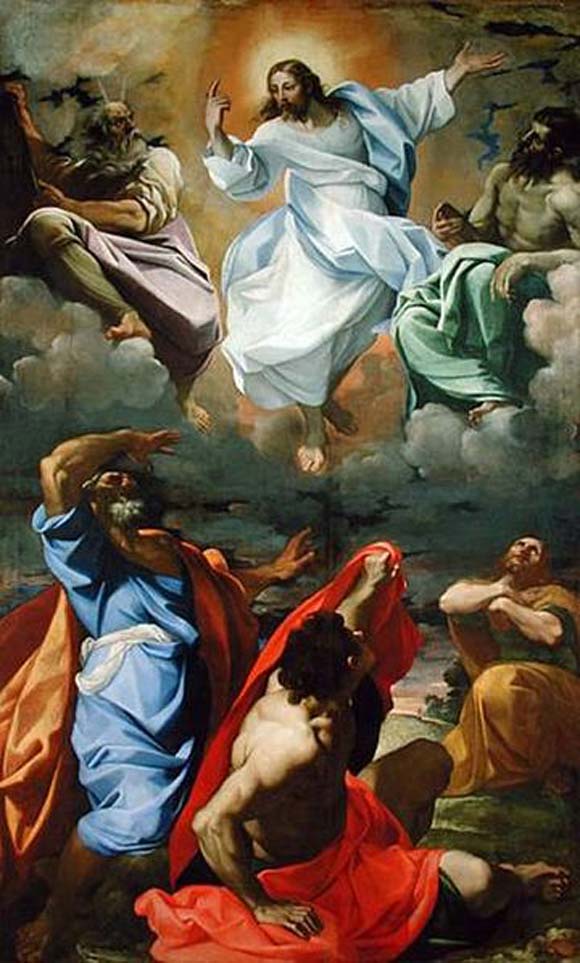
Feast of the Transfiguration
1.73k
Terror is truly a natural, human response to the Transfiguration. Peter, James and John are confronted with the blinding glory of Jesus’s divinity and they can hardly bear it. Perhaps they recalled Daniel’s vision of the Ancient of Days, that fiery majesty, that awesome glory (Dan. 7). Even ‘the mountains melt like wax before the Lord’ (Ps. 97:5), so how could human frailty fare any better? But we may also wonder, since the truth is that God loves us, and ‘perfect love casts out fear’ (1 Jn 4:18), whether fear is ever an appropriate reaction to God’s presence among us?
 I explored these themes of fear and truth at the Transfiguration with the 7-11-year-olds of the Blackfriars Family Mass earlier this year, by talking about boggarts. If you’ve read Harry Potter, you’ll know boggarts are malevolent shapeshifters which adopt the appearance of whatever you most fear (a giant spider, a mother-in-law, etc.). We are all so full of fears that the boggart is really spoilt for choice. We fear things in our environment, things that could happen to us or our loved ones (losing our job, falling ill, or worse), and other people who can hurt us. Perhaps most of all, we fear ourselves, with all our frailties and failures. We fear that, deep down, we are not as good as we’d like to imagine. We fear we have a corrupt core. We fear, in short, that our own transfiguration would show us monsters. The boggart, however, has no core, no ‘deep down’ at all, only a superficial power of illusion. It is easily dismissed when its ridiculous, hollow reality is laughed away. It is truth, like love, that casts out fear.
I explored these themes of fear and truth at the Transfiguration with the 7-11-year-olds of the Blackfriars Family Mass earlier this year, by talking about boggarts. If you’ve read Harry Potter, you’ll know boggarts are malevolent shapeshifters which adopt the appearance of whatever you most fear (a giant spider, a mother-in-law, etc.). We are all so full of fears that the boggart is really spoilt for choice. We fear things in our environment, things that could happen to us or our loved ones (losing our job, falling ill, or worse), and other people who can hurt us. Perhaps most of all, we fear ourselves, with all our frailties and failures. We fear that, deep down, we are not as good as we’d like to imagine. We fear we have a corrupt core. We fear, in short, that our own transfiguration would show us monsters. The boggart, however, has no core, no ‘deep down’ at all, only a superficial power of illusion. It is easily dismissed when its ridiculous, hollow reality is laughed away. It is truth, like love, that casts out fear.
The Transfiguration is, of course, a moment of truth, a revelation that the glory of God the Father belongs to Jesus even as a mortal man on earth. Outshining Moses and Elijah, who represent the Law and Prophets, the radiant Jesus provides a miraculous foretaste of his heavenly glory. So, as St Thomas emphasises (ST 3.45.2), this is a moment of utter clarity. Jesus shows his disciples (and us) that the road to the Cross will end in glorious triumph. He wants their fear (and ours) to give way to joy. ‘Arise, and be not afraid.’ (Matt. 17:7)
Let’s be clear: Jesus’s humanity is in no way obliterated by his divinity, but the two natures are perfectly united in the one person. As St Irenaeus says, ‘The glory of God is a human being fully alive.’
Let’s be clear: deep down we are good people, lovingly created by God to praise his majesty and enjoy his precious gift of life. We all fall short of his glory (Rom. 3:23) but our sins are forgiven in Christ and he wants us to share in his divine glory too (2 Cor. 3:18; Phil. 3:21). So, we have no reason to fear ourselves.
Let’s be clear, too, that it is only through faith that we can face the truth and overcome out fears. St Peter, when his fear turns to faith after the Resurrection of Jesus, preaches ‘the prophetic message that is altogether reliable’ (2 Pet. 1:19). In good faith, Peter had earlier recognised the present gulf between his imperfection and God’s perfection: ‘Lord, depart from me, a sinner’ (Luke 5:8). But it is also faith that enables Peter to say, despite his fears, ‘Rabbi, it is good for us to be here.’ Even if, like Peter, we do not quite overcome all our fears, let us still count on that same faith to carry us through to glory.


